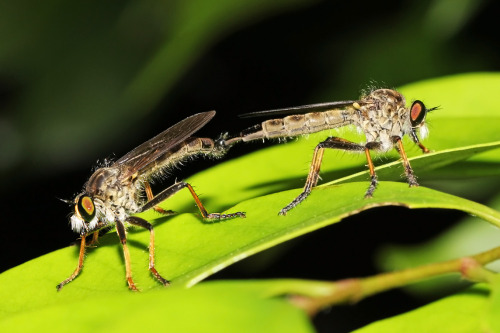#asilidae
aCyrtopogonmarginalis becomes frustrated as it fails to pierce the armor of a click beetle, similar to how i felt upon realizing i, a self-proclaimed robberfly superfan, was unaware that yesterday was world robberfly day
(Massachusetts, 5/25/19)

Hanging thief robberfly (Diogmitescrudelis) preying on a large sweat bee (Dieunomiaheteropoda). (Florida, 9/2/21)
From what I’ve observed, Diogmites’habit of dangling from one or two legs while handling prey seems to help them make a quick escape if disturbed by a larger predator while feeding, but also probably keeps dangerous stinging prey at a safe distance from the fly’s body as they struggle before the venom sets in.
Sometimes reaching nearly 2” in length, D.crudelis is the largest hanging thief and one of the largest north american robberflies overall. Its scientific name translates as something along the lines of “ruthless pursuer” or “cruel hunter”

Florida beekiller (Mallophorabomboides) feeding on a Polistes paper wasp (Florida, 9/25/21).
This huge hairy robberfly found primarily in open habitats in Florida is not only a bumblebee mimic, but also a specialist predator that feeds almost exclusively on bees and wasps. A related species from South America, M. ruficauda, sometimes eats enough bees to cause 80% losses in honey production around apiaries.
The bee mimicry of Mallophora is typically assumed to be an antipredator adaptation, but it has also been hypothesized that they practice aggressive mimicry, appearing as a bumblebee to avoid alarming their prey.

an absolute bastard of a giant robberfly (Promachusbastardii) preying on a honeybee
(Florida, 4/7/21)

